

Insert moulding refers to the moulding method in which the mould is filled with pre-prepared inserts of different materials, injected with resin, and the molten material is joined with the inserts to form an integrated product.
Outsert moulding refers to the process of embedding the injection moulded parts on a local part of the metal plate surface. Its characteristics are as follows:
1. The combination of the resin's easy formability, bendability and metal's rigidity, strength and heat resistance can be made into a complex and exquisite metal-plastic integrated product.
2. In particular, the combination of the insulation of the resin and the conductivity of the metal makes the moulded product satisfy the basic functions of electrical products.
3. The pre-moulding combination of multiple inserts makes the post-engineering of the product unit combination more rational.
4. Insert products are not limited to metal, but also include cloth, paper, wire, plastic, glass, wood, coil, electrical parts, etc.
5. For rigid moulding products and curved elastic moulding products on rubber gaskets, the complicated operation of arranging the sealing rings can be omitted after the integrated products are made by outsert moulding, which makes the automatic combination of the subsequent processes easier.
6. Compared with the press-in moulding method, the gap between the metal insert can be designed narrower because of the fusion of the molten material and the metal insert, and it has the higher reliability.
HanKing Mould is an insert moulding manufacturer you can trust.






 Call us on:
Call us on:  Email Us:
Email Us:  No.23, XingYi Road, Wusha Community, Chang'an Town, Dongguan City, Guangdong Province, China.
No.23, XingYi Road, Wusha Community, Chang'an Town, Dongguan City, Guangdong Province, China.